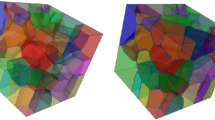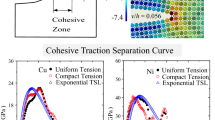Abstract
Deformation and failure processes of crystalline materials are governed by complex phenomena at multiple scales. It is necessary to couple these scales for physics-based modeling of these phenomena, while overcoming limitations of modeling at individual scales. To address this issue, this paper develops self-consistent elastic constitutive and crack propagation relations of crystalline materials containing atomic scale cracks, from observations made in a concurrent multi-scale simulation system coupling atomistic and continuum domain models. The concurrent multi-scale model incorporates a finite temperature atomistic region containing the crack, a continuum region represented by a self-consistent crystal elasticity constitutive model, and a handshaking interphase region. Atomistic modeling is done by the molecular dynamics code LAMMPS, while continuum modeling is conducted by the finite element method. For single crystal nickel a nonlinear and nonlocal crystal elasticity constitutive relation is derived, consistent with the atomic potential function. An efficient, staggered solution scheme with parallel implementation is designed for the coupled problem. The atomistic–continuum coupling is achieved by enforcing geometric compatibility and force equilibrium in the interphase region. Quantitative analyses of the crack propagation process focuses on size dependence, strain energy release rate, crack propagation rate and degradation of the local stiffness. The self-consistent constitutive and crack propagation relations, derived from the concurrent model simulation results are validated by comparing results from the concurrent and full FE models. Excellent accuracy and enhanced efficiency are observed in comparison with pure MD and concurrent model results.












Similar content being viewed by others
References
Abraham F, Brodbeck D, Rudge W, Xu X (1997) A molecular dynamics investigation of rapid fracture mechanics. J Mech Phys Solids 45:1595–1619
Aifantis EC (1984) On the microstructural origin of certain inelastic models. J Eng Mater Technol 106(4):326–330
Anderson TL (2005) Fracture mechanics: fundamentals and applications. CRC Press, Boca Raton
Askes H, Aifantis EC (2011) Gradient elasticity in statics and dynamics: an overview of formulations, length scale identification procedures, finite element implementations and new results. Int J Solids Struct 48:1962–1990
Badia S, Bochev P, Lehoucq R, Parks M, Fish J, Nuggehally MA, Gunzburger M (2007) A force-based blending model foratomistic-to-continuum coupling. Int J Multiscale Comput Eng 5(5):387–406
Badia S, Parks M, Bochev P, Gunzburger M, Lehoucq R (2008) On atomistic-to-continuum coupling by blending. Multiscale Model Simul 7(1):381–406
Budiansky B (1965) On the elastic moduli of some heterogeneous materials. J Mech Phys Solids 13:223–227
Columbus D, Grujicic M (2001) A comparative discrete-dislocation/nonlocal crystal-plasticity analysis of plane-strain mode I fracture. Mater Sci Eng A 180:138–161
Farrissey L, Ludwig M, McHugh PE, Schmauder S (2000) An atomistic study of void growth in single crystalline copper. Comput Mater Sci 18(1):102–117
Ghosh S (2011) Micromechanical analysis and multi-scale modeling using the Voronoi cell finite element method. CRC Press, Boca Raton
Grujicic M, Cao G, Batchu S (2003) Crystal plasticity-based finite element analysis of deformation and fracture of polycrystalline lamellar \(\gamma \)-tial +\(\alpha 2\)-ti\(_3\)al alloys. J Mater Sci 38:209–232
Gumbsch P (1995) An atomistic study of brittle fracture: toward explicit failure criteria from atomistic modeling. J Mater Res 10:2897–2907
Hill R (1965) A self-consistent mechanics of composite materials. J Mech Phys Solids 13:213–222
Honeycutt D, Anderson H (1987) Molecular dynamics study of melting and freezing of small Lennard-Jones clusters. J Chem Phys 91:4950–4963
Kachanov LM (1986) Introduction to continuum damage mechanics. Springer, Berlin
Kadau K, Germann T, Lomdahl P (2006) Molecular dynamics comes of age: 320-billion-atom simulation on BlueGene/L. Int J Mod Phys 17:1755–1761
Maranganti R, Sharma P (2007) A novel atomistic approach to determine strain-gradient elasticity constants: tabulation and comparison for various metals, semiconductors, silica, polymers and the (ir) relevance for nanotechnologies. J Mech Phys Solids 55(9):1823–1852
Miller R, Ortiz M, Phillips R, Shenoy V, Tadmor E (1998) Quasicontinuum models of fracture and plasticity. Eng Fract Mech 61(3):427–444
Mishin Y, Farkas D, Mehl M, Papaconstantopoulos D (1999) Interatomic potentials for monoatomic metals from experimental data and ab initio calculations. Phys Rev B 59(5):3393
Ortiz M, Pandolfi A (1999) Temperature and strain-rate dependence of surface dislocation nucleation. Int J Numer Methods Eng 44:1267–1282
Plimpton S (1995) Fast parallel algorithms for short-range molecular dynamics. J Comput Phys 117:1–19
Roe KL, Siegmund T (2003) An irreversible cohesive zone model for interface fatigue crack simulation. Int J Numer Method Eng 70:307–322
Saether E, Yamakov V, Glaessgen EH (2009) An embedded statistical method for coupling molecular dynamics and finite element analyses. Int J Numer Methods Eng 78(11):1292–1319
Sarma V, Reddy P (1973) Third-order elastic constants of single crystal nickel at 80ąã k. Phys Status Solid (a) 16(2):413–418
Sharon E, Fineberg J (1999) Confirming the continuum theory of dynamic brittle fracture for fast cracks. Nature 397(6717):333–335
Shenoy V, Miller R, Tadmor E, Rodney D, Phillips R, Ortiz M (1999) An adaptive finite element approach to atomic-scale mechanics-the quasicontinuum method. J Mech Phys Solids 47(3):611–642
Shimomura Y, Kiritani M, Mukouda I (2003) Computer simulation study of the atomistic mechanism of deformation and fracture initiation in thin FCC metal films. Mater Sci Eng A 350(1–2):238–244
Spearot D, Jacob K, McDowell D (2004) Non-local separation constitutive laws for interfaces and their relation to nanoscale simulations. Mech Mater 36:825–847
Tadmor EB (1996) The quasicontinuum method. Ph.D. thesis, Brown University
**ao S, Belytschko T (2004) A bridging domain method for coupling continua with molecular dynamics. Comput Methods Appl Mech Eng 193(17):1645–1669
**ong L, Deng Q, Tucker GJ, McDowell DL, Chen Y (2012) Coarse-grained atomistic simulations of dislocations in Al, Ni and Cu crystals. Int J Plast 38:86–101
Yamakov V, Saether E, Phillips DR, Glaessgen EH (2006) Molecular-dynamics simulation-based cohesive zone representation of intergranular fracture processes in aluminum. J Mech Phys Solids 54(9):1899–1928
Yamakov V, Saether E, Glaessgen E (2008) Multiscale modeling of intergranular fracture in aluminum: constitutive relation for interface debonding. J Mater Sci 43:7488–7494
Zhang J, Ghosh S (2013) Molecular dynamics based study and characterization of deformation mechanisms near a crack in a crystalline material. J Mech Phys Solids 61(8):1670–1690
Zhou S, Lomdahl P, Voter A, Holian B (1998) A molecular dynamics investigation of rapid fracture mechanics. Eng Fract Mech 61:173–187
Zhou X, Zimmerman J, Reedy E, Moody N (2008) Molecular dynamics simulation based cohesive surface representation of mixed mode fracture. Mech Mater 40:832–845
Zhu T, Li J, Yip S (2004) Atomistic study of dislocation loop emission from a crack tip. Phys Rev Lett 93(2):025503
Zhu T, Li J, Samanta A, Leach A, Gall K (2008) Temperature and strain-rate dependence of surface dislocation nucleation. Phys Rev Lett 100(2):025502
Zimmerman JA, Bammann DJ, Gao H (2009) Deformation gradients for continuum mechanical analysis of atomistic simulations. Int J Solids Struct 46(2):238–253
Acknowledgements
This work has been supported by a mechanics of materials and strength, materials and surface engineering research program sponsored by the National Science Foundation, Mechanics and Structure of Materials Program through Grant No. CMMI-1200231 (Program Manager: Dr. Alexis Lewis). The authors gratefully acknowledge this support. Computing support by the Homewood High Performance Compute Cluster (HHPC) and Maryland Advanced Research Computing Center (MARCC) is gratefully acknowledged. Finally authors thank Subhendu Chakraborty, Jiahao Cheng, Shu Guo for important discussions.
Author information
Authors and Affiliations
Corresponding author
Rights and permissions
About this article
Cite this article
Ghosh, S., Zhang, J. Elastic crack propagation model for crystalline solids using a self-consistent coupled atomistic–continuum framework. Int J Fract 208, 171–189 (2017). https://doi.org/10.1007/s10704-017-0232-0
Received:
Accepted:
Published:
Issue Date:
DOI: https://doi.org/10.1007/s10704-017-0232-0




